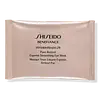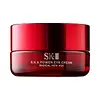What's inside
What's inside
 Key Ingredients
Key Ingredients

 Benefits
Benefits

 Concerns
Concerns

 Ingredients Side-by-side
Ingredients Side-by-side

Water
Skin ConditioningButylene Glycol
HumectantPentaerythrityl Tetraethylhexanoate
EmollientDiphenylsiloxy Phenyl Trimethicone
Skin ConditioningGlycerin
HumectantDipropylene Glycol
HumectantPEG-60 Hydrogenated Castor Oil
EmulsifyingTocopheryl Acetate
AntioxidantPhenoxyethanol
PreservativeAlcohol
AntimicrobialCarbomer
Emulsion StabilisingSodium Citrate
BufferingParfum
MaskingBHT
AntioxidantSqualane
EmollientXanthan Gum
EmulsifyingPotassium Hydroxide
BufferingRetinol
Skin ConditioningPolysorbate 20
EmulsifyingCitric Acid
BufferingTrisodium EDTA
Magnesium Ascorbyl Phosphate
AntioxidantButylphenyl Methylpropional
PerfumingSapindus Mukorossi Peel Extract
Skin ConditioningLimonene
PerfumingLinalool
PerfumingUncaria Gambir Extract
AstringentCitronellol
PerfumingAlpha-Isomethyl Ionone
PerfumingPaeonia Suffruticosa Root Extract
Skin ProtectingGeraniol
PerfumingBenzyl Benzoate
AntimicrobialSodium Acetylated Hyaluronate
HumectantHydroxyproline
Skin ConditioningChlorella Vulgaris Extract
Skin ConditioningCI 75130
Cosmetic ColorantWater, Butylene Glycol, Pentaerythrityl Tetraethylhexanoate, Diphenylsiloxy Phenyl Trimethicone, Glycerin, Dipropylene Glycol, PEG-60 Hydrogenated Castor Oil, Tocopheryl Acetate, Phenoxyethanol, Alcohol, Carbomer, Sodium Citrate, Parfum, BHT, Squalane, Xanthan Gum, Potassium Hydroxide, Retinol, Polysorbate 20, Citric Acid, Trisodium EDTA, Magnesium Ascorbyl Phosphate, Butylphenyl Methylpropional, Sapindus Mukorossi Peel Extract, Limonene, Linalool, Uncaria Gambir Extract, Citronellol, Alpha-Isomethyl Ionone, Paeonia Suffruticosa Root Extract, Geraniol, Benzyl Benzoate, Sodium Acetylated Hyaluronate, Hydroxyproline, Chlorella Vulgaris Extract, CI 75130
Water
Skin ConditioningGlycerin
HumectantGalactomyces Ferment Filtrate
HumectantNiacinamide
SmoothingIsohexadecane
EmollientButylene Glycol
HumectantPentylene Glycol
Skin ConditioningIsopropyl Isostearate
EmollientPetrolatum
EmollientDimethicone
EmollientCaprylic/Capric Triglyceride
MaskingVinyl Dimethicone/Methicone Silsesquioxane Crosspolymer
Polyacrylamide
Phytosteryl/Behenyl/Octyldodecyl Lauroyl Glutamate
Skin ConditioningStearyl Alcohol
EmollientCetyl Alcohol
EmollientC13-14 Isoparaffin
EmollientBehenyl Alcohol
EmollientTocopheryl Acetate
AntioxidantPolymethylsilsesquioxane
Panthenol
Skin ConditioningNylon-12
Benzyl Alcohol
PerfumingDimethiconol
EmollientMethylparaben
PreservativePEG-100 Stearate
Laureth-7
EmulsifyingCetearyl Glucoside
EmulsifyingCetearyl Alcohol
EmollientStearic Acid
CleansingMica
Cosmetic ColorantDisodium EDTA
Propylparaben
PreservativeSodium PEG-7 Olive Oil Carboxylate
EmulsifyingEthylparaben
PreservativePEG-7 Glyceryl Cocoate
EmulsifyingChlorella Vulgaris Extract
Skin ConditioningSodium Hydroxide
BufferingHydrolyzed Lupine Protein
Skin ConditioningDecyl Glucoside
CleansingMedicago Sativa Extract
TonicPhenoxyethanol
PreservativeLactic Acid
BufferingSodium Benzoate
MaskingHydrolyzed Soy Protein
HumectantPolyquaternium-7
Tin Oxide
AbrasiveEthylhexylglycerin
Skin ConditioningPalmitoyl Dipeptide-7
Skin ConditioningHydrolyzed Yeast Protein
Skin ConditioningAcanthopanax Senticosus Root Extract
Skin ConditioningPalmitoyl Pentapeptide-4
Skin ConditioningMethylsilanol Tri-PEG-8 Glyceryl Cocoate
EmulsifyingAmmonium Polyacrylate
StabilisingMethicone
EmollientTocopherol
AntioxidantCynara Scolymus Leaf Extract
Skin ConditioningBHT
AntioxidantParfum
MaskingLimonene
PerfumingLinalool
PerfumingCI 77891
Cosmetic ColorantCI 77492
Cosmetic ColorantWater, Glycerin, Galactomyces Ferment Filtrate, Niacinamide, Isohexadecane, Butylene Glycol, Pentylene Glycol, Isopropyl Isostearate, Petrolatum, Dimethicone, Caprylic/Capric Triglyceride, Vinyl Dimethicone/Methicone Silsesquioxane Crosspolymer, Polyacrylamide, Phytosteryl/Behenyl/Octyldodecyl Lauroyl Glutamate, Stearyl Alcohol, Cetyl Alcohol, C13-14 Isoparaffin, Behenyl Alcohol, Tocopheryl Acetate, Polymethylsilsesquioxane, Panthenol, Nylon-12, Benzyl Alcohol, Dimethiconol, Methylparaben, PEG-100 Stearate, Laureth-7, Cetearyl Glucoside, Cetearyl Alcohol, Stearic Acid, Mica, Disodium EDTA, Propylparaben, Sodium PEG-7 Olive Oil Carboxylate, Ethylparaben, PEG-7 Glyceryl Cocoate, Chlorella Vulgaris Extract, Sodium Hydroxide, Hydrolyzed Lupine Protein, Decyl Glucoside, Medicago Sativa Extract, Phenoxyethanol, Lactic Acid, Sodium Benzoate, Hydrolyzed Soy Protein, Polyquaternium-7, Tin Oxide, Ethylhexylglycerin, Palmitoyl Dipeptide-7, Hydrolyzed Yeast Protein, Acanthopanax Senticosus Root Extract, Palmitoyl Pentapeptide-4, Methylsilanol Tri-PEG-8 Glyceryl Cocoate, Ammonium Polyacrylate, Methicone, Tocopherol, Cynara Scolymus Leaf Extract, BHT, Parfum, Limonene, Linalool, CI 77891, CI 77492
Ingredients Explained
These ingredients are found in both products.
Ingredients higher up in an ingredient list are typically present in a larger amount.
BHT is a synthetic antioxidant and preservative.
As an antioxidant, it helps your body fight off free-radicals. Free-radicals are molecules that may damage your skin cells.
As a preservative, it is used to stabilize products and prevent them from degrading. Specifically, BHT prevents degradation from oxidation.
The concerns related to BHT come from oral studies; this ingredient is currently allowed for use by both the FDA and EU.
However, it was recently restricted for use in the UK as of April 2024.
Learn more about BHTButylene Glycol (or BG) is used within cosmetic products for a few different reasons:
Overall, Butylene Glycol is a safe and well-rounded ingredient that works well with other ingredients.
Though this ingredient works well with most skin types, some people with sensitive skin may experience a reaction such as allergic rashes, closed comedones, or itchiness.
Learn more about Butylene GlycolChlorella Vulgaris Extract comes from a green microalga. It is hydrating and contains antioxidants.
Studies also show Chlorella Vulgaris may help in rebuilding collagen and elastin. This ingredient is made up of lipids, carbohydrates, and chlorophyll.
Fun fact: This ingredient is commonly used as food additive in Japan.
Learn more about Chlorella Vulgaris ExtractGlycerin is already naturally found in your skin. It helps moisturize and protect your skin.
A study from 2016 found glycerin to be more effective as a humectant than AHAs and hyaluronic acid.
As a humectant, it helps the skin stay hydrated by pulling moisture to your skin. The low molecular weight of glycerin allows it to pull moisture into the deeper layers of your skin.
Hydrated skin improves your skin barrier; Your skin barrier helps protect against irritants and bacteria.
Glycerin has also been found to have antimicrobial and antiviral properties. Due to these properties, glycerin is often used in wound and burn treatments.
In cosmetics, glycerin is usually derived from plants such as soybean or palm. However, it can also be sourced from animals, such as tallow or animal fat.
This ingredient is organic, colorless, odorless, and non-toxic.
Glycerin is the name for this ingredient in American English. British English uses Glycerol/Glycerine.
Learn more about GlycerinLimonene is a fragrance that adds scent and taste to a formulation.
It's found in the peel oil of citrus fruits and other plants such as lavender and eucalyptus. The scent of limonene is generally described as "sweet citrus".
Limonene acts as an antioxidant, meaning it helps neutralize free radicals.
When exposed to air, oxidized limonene may sensitize the skin. Because of this, limonene is often avoided by people with sensitive skin.
The term 'fragrance' is not regulated in many countries. In many cases, it is up to the brand to define this term. For instance, many brands choose to label themselves as "fragrance-free" because they are not using synthetic fragrances. However, their products may still contain ingredients such as essential oils that are considered a fragrance.
Learn more about LimoneneLinalool is a fragrance and helps add scent to products. It's derived from common plants such as cinnamon, mint, citrus, and lavender.
Like Limonene, this ingredient oxidizes when exposed to air. Oxidized linalool can cause allergies and skin sensitivity.
This ingredient has a scent that is floral, spicy tropical, and citrus-like.
Learn more about LinaloolParfum is a catch-all term for an ingredient or more that is used to give a scent to products.
Also called "fragrance", this ingredient can be a blend of hundreds of chemicals or plant oils. This means every product with "fragrance" or "parfum" in the ingredients list is a different mixture.
For instance, Habanolide is a proprietary trade name for a specific aroma chemical. When used as a fragrance ingredient in cosmetics, most aroma chemicals fall under the broad labeling category of “FRAGRANCE” or “PARFUM” according to EU and US regulations.
The term 'parfum' or 'fragrance' is not regulated in many countries. In many cases, it is up to the brand to define this term.
For instance, many brands choose to label themselves as "fragrance-free" because they are not using synthetic fragrances. However, their products may still contain ingredients such as essential oils that are considered a fragrance by INCI standards.
One example is Calendula flower extract. Calendula is an essential oil that still imparts a scent or 'fragrance'.
Depending on the blend, the ingredients in the mixture can cause allergies and sensitivities on the skin. Some ingredients that are known EU allergens include linalool and citronellol.
Parfum can also be used to mask or cover an unpleasant scent.
The bottom line is: not all fragrances/parfum/ingredients are created equally. If you are worried about fragrances, we recommend taking a closer look at an ingredient. And of course, we always recommend speaking with a professional.
Learn more about ParfumPhenoxyethanol is a preservative that has germicide, antimicrobial, and aromatic properties. Studies show that phenoxyethanol can prevent microbial growth. By itself, it has a scent that is similar to that of a rose.
It's often used in formulations along with Caprylyl Glycol to preserve the shelf life of products.
Tocopheryl Acetate is AKA Vitamin E. It is an antioxidant and protects your skin from free radicals. Free radicals damage the skin by breaking down collagen.
One study found using Tocopheryl Acetate with Vitamin C decreased the number of sunburned cells.
Tocopheryl Acetate is commonly found in both skincare and dietary supplements.
Learn more about Tocopheryl AcetateWater. It's the most common cosmetic ingredient of all. You'll usually see it at the top of ingredient lists, meaning that it makes up the largest part of the product.
So why is it so popular? Water most often acts as a solvent - this means that it helps dissolve other ingredients into the formulation.
You'll also recognize water as that liquid we all need to stay alive. If you see this, drink a glass of water. Stay hydrated!
Learn more about Water